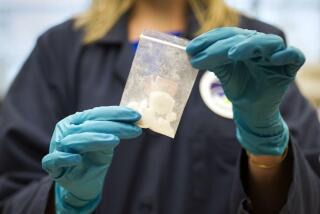Drug cartel money-laundering indictment is first major effort against <i>hawala</i> tactics
Federal authorities said Friday they had broken up an international network of money launderers who moved millions of dollars for the Sinaloa drug cartel and other criminal groups using an off-the-books system of remittance that bypassed traditional banks.
Gurkaran Singh Isshpunani, 34, who prosecutors allege is the leader of the scheme, appeared in a Los Angeles federal courtroom late Friday afternoon to face charges that he helped launder more than $4.5 million in narcotics proceeds from drug sales in Canada and the United States. He pleaded not guilty and was held without bail, according to a spokesman for the U.S. attorney’s office.
Isshpunani was arrested last month in Buffalo, N.Y., as he tried to cross into the U.S. from Canada, according to a statement released by prosecutors. A federal magistrate ordered that Isshpunani be sent to Los Angeles. Fourteen others who are charged in the case have been arrested in recent months, and authorities continue to search for seven more people.
The case is the first major effort to target this method of laundering, justice officials said in a statement released Friday.
A 36-page indictment accuses Isshpunani and others of operating a hawala — a method for transferring funds between people that avoids actually moving cash and has long been in use in central and south Asia and parts of Africa. At the center of a hawala are brokers who receive cash from clients looking to transfer the funds to a person in another city or country. That broker — called a hawaladar — then contacts a trusted hawaladar near the recipient and instructs him to pay the recipient.
Hawaladars do not use written contracts to document their transactions, the indictment said. And they are careful to keep the amount of the credits and debts they have with each other in balance to avoid the need to transfer actual cash to settle debts. Variations of the hawala system are used widely in Afghanistan, India and other countries in lieu of official banks to make both legal and illicit transactions.
With hawalas operating in Canada and the U.S., operatives within the Sinaloa cartel and other Mexican drug organizations recognized an avenue for moving large sums of money that arose from drug sales without having to launder it through businesses, prosecutors alleged.
The indictment details several complex exchanges of money that prosecutors say were orchestrated by Isshpunani and the other hawaladars to allow narcotics traffickers to move money from drug sales in Canada back to Mexico.
In one example, over the course of a few days in March 2012, two men arranged for the transfer of more than $500,000 during a series of phone calls during which they spoke in coded language, according to the indictment.
Once the hawaladar in Canada confirmed he had received the money from traffickers, his partner in Los Angeles packed $522,000 into two cardboard boxes and drove to meet a drug courier in a parking lot in Alhambra, the indictment says. The two men then drove to a nearby religious temple, where the hawaladar is believed to have handed over the cash to the courier.
From there, according to the indictment, the courier drove the money to a house in Coachella, where two other men transferred the cash into another vehicle “for the purpose of transporting the money” to others. Each of the five men accused of being involved in the transaction are charged in the indictment.
A day after the first bundle of cash was moved, the same hawaladars arranged for another $600,000 to be dispersed in Los Angeles to the courier, the indictment alleges.
The suspected courier, Bradley Martin, also picked up drugs from cartel stash houses in the region and delivered them to other suspects for transport to Canada, according to the indictment. Martin, 54, of Carlsbad has pleaded not guilty.
Isshpunani was described by prosecutors as leading the group of hawaladars. In April 2012, he orchestrated a $400,000 transfer between Canada and drug traffickers in Los Angeles, the indictment alleges. Prosecutors also accused him of arranging for a hawaladar in Los Angeles to pay a man who transported cocaine and methamphetamine on behalf of traffickers.
In all, the people charged in the case were involved in the trafficking of 29 kilograms of cocaine and approximately 90 pounds of methamphetamine, federal officials claimed.
At least one hawaladar was operating in India for some of the transactions, prosecutors alleged in the indictment.
Twitter: @joelrubin
More to Read
Sign up for Essential California
The most important California stories and recommendations in your inbox every morning.
You may occasionally receive promotional content from the Los Angeles Times.











